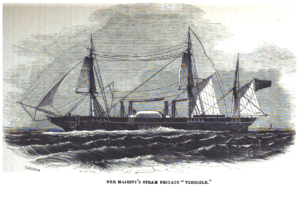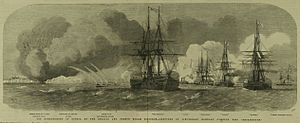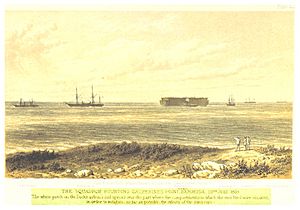HMS Terrible (1845) facts for kids

1845 engraving of HMS Terrible
|
|
Quick facts for kids History |
|
|---|---|
| Name | HMS Terrible |
| Ordered |
|
| Builder |
|
| Laid down | November 1843 |
| Launched | 6 February 1845 |
| Completed | 25 March 1846 |
| Renamed |
|
| Fate | Sold for breaking up on 7 July 1879 |
| General characteristics | |
| Type | First class steam paddle frigate |
| Displacement | 3,189 tons |
| Tons burthen | 1,847 7⁄94 bm |
| Length |
|
| Beam | 42 ft 6 in (12.95 m) |
| Draught | 27 ft (8.2 m) |
| Propulsion |
|
| Speed | 10.9kts under engines |
| Complement | 200 |
| Armament |
|
HMS Terrible was a huge, powerful ship for its time. It was the biggest steam-powered wooden warship with paddle wheels ever built for the British Royal Navy. When it was designed, it was a truly impressive vessel.
Contents
About HMS Terrible
How Big Was It?
HMS Terrible was designed by Oliver Lang, a skilled ship designer. It was built at Woolwich Dockyard. This ship was really long, measuring 226 feet from end to end. That's longer than many football fields! It was even 21 feet longer than another famous ship, HMS Trafalgar.
Building the Ship
The construction of Terrible began at Deptford Dockyard in November 1843. It was first going to be called HMS Simoom, but its name was changed in December 1842. The ship was officially launched into the water on February 6, 1845.
Terrible was built using strong types of wood. These included Honduras mahogany, East India teak, and well-aged English oak. It had an extra deck compared to a similar ship, Retribution. One unique thing about Terrible was its look: it had three masts and four funnels. The funnels were placed in two pairs, far apart, which made it stand out from other ships of its kind.
How It Moved
The powerful engines for Terrible were made by Maudslay and Co. They were similar to the engines used on the ship Retribution. These engines cost a lot of money for the time, about 41,250 British Pounds. Each engine was rated at 400 nominal horsepower, which means they were very strong.
The engines themselves weighed 212 tons. The boilers, which made the steam, weighed 250 tons. The water inside the boilers added another 138 tons. The large paddle wheels weighed 44 tons, and the coal storage areas weighed 16 tons. All together, the propulsion system weighed 560 tons. The ship could carry 800 tons of coal to fuel its journey. This means a total of 1,360 tons was dedicated just to making the ship move!
What Weapons Did It Carry?
Even with all the heavy machinery, there was still enough space for many powerful guns. The original plan was to equip Terrible with 16 56-pounder guns and 4 10-inch shell guns. The 56-pounders would be placed along the sides of the ship, between the decks. Two of the shell guns would be on rotating mounts, and two others would be on the upper deck.
The ship also carried smaller guns for its boats. These included a brass 6-pounder and two 18-pounder carronades, plus two 12-pounder carronades. Some of these smaller guns were also used for saluting or sending signals. Later, when the ship was in service, it was armed with 8 68-pounder guns and 8 56-pounder guns. By the time of the Crimean War, the 56-pounder guns were being replaced by the more powerful 68-pounders.
Ship's Adventures
Early Service
Terrible officially started its service on December 5, 1845. Its first captain was Captain William Ramsay. The ship first joined the Channel Fleet, which protected the waters around Britain.
In 1847, Terrible was sent to Portuguese Angola. Its mission was to transport Portuguese exiles, led by the Count of Bonfim, back to Lisbon, Portugal. This was part of an agreement called the Convention of Gramido. In January 1850, the ship accidentally ran aground near Plymouth while traveling to Lisbon. Luckily, it was refloated and brought safely into Plymouth. After this, Terrible served in the Mediterranean Sea.
Fighting in the Crimean War
HMS Terrible played an important role during the Crimean War. On November 6, 1853, under the command of Captain James Johnstone McCleverty, it left England. On board was Rear-Admiral Sir Edmund Lyons, who was becoming the second-in-command of the Mediterranean Fleet.
Terrible then joined Admiral James Dundas's fleet in the Black Sea. There, it actively served during the war. On October 7, 1854, some of its powerful 68-pounder guns were taken off the ship at Balaclava. These guns were then used on land to help with the siege of Sevastopol. During the naval attack on Sevastopol on October 17, Terrible was the northernmost ship in the Allied line. It successfully attacked and damaged Fort Constantine, a strong fort protecting Sevastopol harbor.
Later Missions
From late 1858 to early 1859, Terrible was used by William Gladstone. He was a special commissioner for the Ionian Islands at the time. In January 1865, the ship ran aground again, this time at Sheerness, Kent.
In 1866, under Captain John Commerell, Terrible helped the famous ship SS Great Eastern lay the fifth Atlantic cable. This was the first time an Atlantic cable was successfully laid, allowing messages to be sent across the ocean!
In 1869, Terrible was one of three ships involved in a very unusual task. They helped move a specially built 'Bermuda' Dry Dock all the way across the Atlantic Ocean. The dry dock was towed by HMS Warrior and HMS Black Prince. Terrible was tied to the back of the dry dock to help steer it like a giant rudder. This amazing journey from Madeira to Ireland Island, Bermuda, took 39 days.
HMS Terrible was eventually taken apart and sold for scrap in 1879, after a long and interesting career.
See also
- List of frigate classes of the Royal Navy



